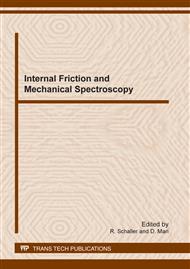p.209
p.215
p.221
p.227
p.233
p.239
p.245
p.251
p.257
Characterization of Defects in Severely Deformed Iron by Mechanical Spectroscopy
Abstract:
We have studied the crystal defects in severely deformed pure iron, by combining mechanical spectroscopy with measurements of Vickers hardness and electrical resistivity. Iron of 99.99% purity and a material in which the C content is further reduced to below 1 at. ppm were deformed to strains up to 5.6 by accumulated roll-bonding. Mechanical loss and dynamic shear modulus of as-deformed samples were measured over the temperature range from –195°C to 800°C. Effects due to dislocations and grain boundaries have been identified. Thermal stabilities of the defects have been examined through variations in the mechanical loss during heating-run and cooling-run measurements. It is found that the small difference in the carbon content influences the densities of defects and microstructure, as well as the thermal stability. They are consistent with the recovery behaviour observed through hardness and resistivity in isochronal annealing experiments.
Info:
Periodical:
Pages:
233-238
Citation:
Online since:
January 2012
Authors:
Price:
Сopyright:
© 2012 Trans Tech Publications Ltd. All Rights Reserved
Share:
Citation:


